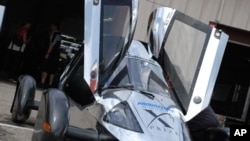The winner of a $5 million prize for the best production-capable vehicle that's able to run the equivalent of 160 kilometers without recharging is - surprisingly - not electric. The Very Light Car runs on ethanol based E85. It has an internal combustion engine, like a regular automobile. But the VLC is anything but regular. Brad Jaeger, an engineer on the Edison 2 team, describes its features.
"Light weight, low aerodynamic drag. Those two virtues are what really led the whole project to where it is today," says Jaeger. "Fuel source agnostic. No matter where the energy comes from, this car is efficient."
As the name implies, E-85 is 85 percent ethanol, which is often made mostly from corn. Although cars run quite efficiently on ethanol, the making of ethanol itself is less than efficient. Not to mention the increase in costs to consumers when the competition for corn makes the price go up. David Friedman of the Union of Concerned Scientists says the key with ethanol is to avoid trading food for fuel.
"The best resources for ethanol are things like wood waste, or grasses, or garbage," says Friedman. "Those are waste products that can be fermented and turned into ethanol to run in your car. The problem with current ethanol is most of it is made from either corn or sugarcane. And that is not the best way to make ethanol. Both because it requires a lot of land and a lot of water, and because it can drive up food prices."
The Very Light Car beat out dozens of competitors to take home the top "X-Prize," worth $5 million last month. Nearly all the other entries ran on batteries.
But batteries have their own drawback. They have to be recharged - often - with electricity that comes from power plants, many of which are coal-powered. And there's the question of what to do with the spent lithium once the battery is no longer usable?
"This is such a new industry that the systems have not yet been put in place," notes Friedman. "That said, the batteries are very valuable products and it's going to be in the best interest of the people making and selling the cars to recycle those battery packs into new battery packs for cars or to sell them and reuse them."
All of these cars were created with a singular focus: to be super efficient, while still meeting consumer comfort and safety standards. To a layman, the differences are negligible, and, despite their efficiency, they are not all exactly ready for prime time driving. But the drive for innovation continues.
"The best way to guarantee we can end America's oil addiction, dramatically reduce oil use around the world and curb global warming pollution, is to invest in a portfolio of technologies," says David Friedman. "Both near term technologies like fuel economy that can save consumers thousands of dollars, even after paying for the improvements in fuel economy, to batteries or fuel cells which are a little further down the road. But ultimately if tied to renewable energy, could be carbon-free."
So, what will be the low-emitting fuel of the future? Perhaps it hasn't been thought of yet.
You can watch all of Rebecca's "Going Green" reports by clicking here.





